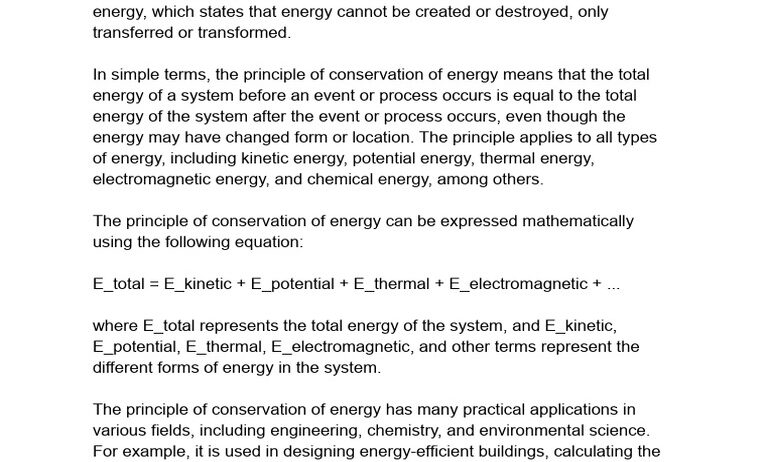The physics of energy conservation stands as a pillar of understanding in both natural and engineered systems. Defined succinctly, the principle of conservation of energy asserts that energy within a closed system remains constant; it can neither be created nor destroyed, only transformed from one form to another. This fundamental postulate serves as a cornerstone not only in the realm of physics but also in the broader discourse surrounding sustainability and climate change.
At the heart of this principle lies the interconnectivity of energy forms. Kinetic, potential, thermal, chemical, and nuclear energies each play distinct roles in the universe. For instance, the transformation of potential energy, such as water stored in a reservoir, into kinetic energy through hydroelectric turbines demonstrates the principle in action. When the water is released, its potential energy converts into kinetic energy, generating electricity. Such a process exemplifies not just energy efficiency but also the need for innovative approaches in harnessing renewable sources.
To fully appreciate the implications of energy conservation, one must delve into its historical context. The 19th-century scientific community saw pivotal contributions from luminaries like James Prescott Joule, whose experiments with mechanical work and heat laid foundational insights into the relationship between energy forms. This exploration fostered what is now known as the first law of thermodynamics. This law articulates that the total energy of an isolated system remains invariant, despite the myriad forms it may adopt.
The implications of these principles extend far beyond theoretical frameworks. In contemporary environmental discussions, energy conservation emerges as a clarion call for sustainable practices. As society confronts the dire consequences of climate change, encapsulated in rising global temperatures and extreme weather events, the quest for energy efficiency acquires renewed urgency. Energy conservation not only reduces the demand for fossil fuels but also diminishes greenhouse gas emissions—two crucial factors in curbing climate change.
Moreover, technological innovations underscore the relevance of energy conservation principles in modern contexts. Advances in materials science, such as the development of photovoltaic cells, illustrate how the conversion of solar energy into electrical energy exemplifies direct applications of conservation concepts. Solar panels, for instance, must be designed to optimize the absorption of sunlight and convert it into usable energy with minimal loss. Such technologies promise to alter the energy landscape significantly, persuading societies to pivot from traditional energy sources to more sustainable alternatives.
The notion of energy conservation also bridges the gap between various sectors, influencing policies and practices in distinct fields. Public policy initiatives aimed at energy efficiency often lean on the premise that conserving energy today promotes ecological resilience tomorrow. For instance, retrofitting older buildings with enhanced insulation techniques or energy-efficient appliances demonstrates how simple adjustments can yield substantial energy savings and, by extension, contribute to environmental conservation.
Furthermore, the behavioral dimension of energy conservation merits consideration. Ingraining an energy conservation mindset within communities can foster a culture of sustainability. Education plays an indispensable role here, as disseminating knowledge about how individual actions—like turning off unused electronics or adopting public transportation—can culminate in significant energy savings. Such conscious decisions amplify collective attempts to reduce carbon footprints.
However, the adoption of energy conservation measures is not without its challenges. A widespread misconception persists that zero energy consumption is an unattainable ideal. In reality, the pursuit of energy efficiency is not about sheer reduction but rather optimizing available resources. This aligned perspective reveals that the complexity of energy systems—whether in residential, commercial, or industrial contexts—requires tailored strategies that meet specific needs without compromising ecological integrity.
Investing in research and development (R&D) constitutes another crucial aspect of advancing energy conservation principles. Government and private sector funding directed towards innovative energy solutions can facilitate the discovery of more efficient processes that not only enhance energy recovery but also diminish waste. For instance, methods of harnessing waste heat in industrial processes embody a pragmatic approach to integrating conservation principles, ensuring that energy expended is maximized rather than squandered.
Looking toward the future, the intersection of energy conservation principles with emerging technologies like artificial intelligence and machine learning presents tantalizing opportunities. These technologies can analyze immense datasets to refine energy use patterns, predict peak demand periods, and optimize operational efficiencies. By processing information at an unprecedented scale, machine learning facilitates a more sophisticated understanding of energy dynamics, ultimately paving the way for smarter, more efficient systems.
In conclusion, the principles of energy conservation represent more than just theoretical constructs; they encompass an ethical imperative that speaks to the core of sustainability. As humanity grapples with the pressing realities of climate change, invoking energy conservation is imperative. The potential ramifications extend into every stratum of society, offering pathways toward a sustainable future where energy is utilized judiciously. By embracing these principles, individuals, communities, and nations can empower themselves to not only mitigate the adverse effects of environmental degradation but also pioneer innovative solutions for generations to come.








